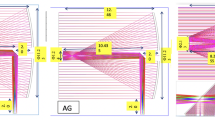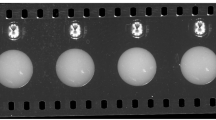Abstract
We present the main features of SIMPLE, the Phase A study of a high resolution near IR spectrograph for the European Extreme Large Telescope and we mention a few science cases which are relevant for the study of planets in the solar system and beyond.
Similar content being viewed by others
Avoid common mistakes on your manuscript.
1 Introduction
High resolution near IR spectroscopy is one of the youngest branches of astronomical research. It is opening new windows in our understanding of several hot topics of modern planet, stellar and extragalactic astrophysics, and it will have a huge impact in the JWST and ALMA era and beyond. The much reduced extinction at these wavelengths also allows to pierce the dust embedding those objects which are heavily obscured in the optical. Moreover, at high redshift several emission and absorption spectral features, commonly exploited when studying local galaxies, are shifted into the near IR. However, despite its scientific potential, the field of high-resolution IR spectroscopy and its related science is still mostly unexplored and developing very slowly, because of the lack of optimized instruments with the necessary combination of spectral resolution, coverage and stability.
High spectral resolution (R∼100,000) and an extreme large telescope (ELT, D∼40 m) represent a unique instrumental combination to perform detailed spectroscopy of faint objects and/or spatially resolved structures, with 1–2 orders of magnitudes better limiting sensitivities and 5–10 times higher spatial resolution than at 4–10 m class telescopes.
2 The SIMPLE Study
SIMPLE is the Phase A study of a high resolution near IR spectrograph for the European ELT. SIMPLE will be fully complementary to JWST, providing the missing high spectral resolution, and to ALMA providing the near IR high resolution spectral counterpart. It will also be fully complementary (in terms of spectral resolution and/or spectral coverage) to the other E-ELT instruments currently under study. The instrumental concept of SIMPLE follows from a detailed study of existing high resolution optical spectrographs. For the technical issues specific to cryogenic IR instruments we took advantage of the information available for CRIRES and of the direct experience we recently gained with the GIANO-TNG IR spectrograph (Oliva et al. 2006). The current baseline characteristics of the spectrograph are as follows:
-
spectrograph in vacuum cooled and thermostated at cryogenic temperatures;
-
fixed position at the telescope;
-
resolving power R = 105 with a 38 milli-arcsec wide and 450 milli-arcsec long entrance slit;
-
pixel sampling of 9 milli-arcsec along the slit;
-
assisted by adaptive optics both to concentrate the light in the slit and to achieve spatial resolutions along the slit at the diffraction limit of the telescope;
-
two observing modes: single object, with complete 0.85–2.5 μm spectral coverage in a single exposure, or long (4 arcsec) slit with partial spectral coverage;
-
commercial echelle grating with cross-dispersing prisms;
-
fixed format, complete spectrum on a 3 × 2k2 (or 3 × 4k2) arrays mosaic.
The core of the spectrometer (see Fig. 1) consists of a three-mirrors anastigmat (TMA) which works in double pass and acts both as collimator and camera. Cross dispersion is performed by means of three prisms in double pass, which provide a minimum inter-order distance of 60 pixels (0.5″). The detector is a mosaic of three 20482 Hawaii-II RG arrays with 18 μm pixels. The spectrometer can also be adapted to a mosaic of three 40962 arrays with 15 μm pixels, a format which may soon become the standard for HgCdTe arrays. The instrument needs to be cooled to liquid nitrogen temperatures (≈70 K) to maintain the internal thermal background seen by the detector below the dark current of the detector itself. Finally, we note that a wide spectral coverage in a single exposure is highly desirable for a proper quantitative spectroscopy aimed, for example, at obtaining a complete screening of chemical abundances in cool stars or extremely accurate radial velocity measurements for extra-solar planet search. A wide spectral coverage is also crucial to unveil the nature and physical properties of poorly explored objects, like e.g. very low mass dwarfs or transient objects.
Optical layout of the SIMPLE spectrograph. The light passes through the field lens (FL) and the focal reducer mirrors (PM1, FR) which reimage the slit on the side of the detector. The light is then collimated (\(\oslash\)180 mm) by the TMA system which feeds the cross-disperser (CRD) and the echelle grating. The dispersed light is focused onto the detector by the same TMA system
3 Science Drivers
Among the unique (i.e. feasible only with an ELT) science that will become possible with SIMPLE, we mention the early nucleosynthesis and chemical enrichment history of the inner Galaxy, the chemical and kinematic properties of the stellar populations in Centaurus and Virgo, the metal and dust content of the highest z Lyman alpha absorption systems and the physics of exo-planet atmospheres. A near IR high resolution spectrograph is also the ideal tool in other hot topics of modern astrophysics, as the characterization of planet atmospheres in the solar system, the search of exo-planets with habitable conditions, the spectro-astrometry of circumstellar disks, the study of stellar magnetic fields, the detailed investigation of the chemistry and kinematics of cool stellar populations in different galactic environments. Having such a spectroscopic facility at an ELT, rather than on existing 8–10 m class telescopes, allows us to pick up and/or resolve objects 3–4 mag fainter and/or at least five times more distant, and/or enlarging the searching volume by at least two orders of magnitude.
3.1 Atmospheres of Planets and Moons in the Solar System
High resolution near IR spectroscopy with an angular pixel scale of 9 milli-arcsec represents a powerful tool to investigate the detailed chemistry and kinematics of methane, water, ammonia hydrate and other possible life tracers in the atmospheres of planets and moons of the solar system. Especially interesting objects are Titan, Enceladus and other icy moons of Saturn (Verbiscea 2006), which are under detailed investigation by the ongoing Cassini mission and for which high resolution spectroscopic follow-ups can be extremely valuable. Indeed at the distance of Saturn, SIMPLE can provide detailed chemical abundances and velocity fields down to ≈3 km/s of moon atmospheres with spatial resolutions from about 70 km to hundreds meters if spectro-astrometry techniques can be applied. Other primary targets are Pluto and its moons, which will be surveyed by the New Horizons space mission. Recently, Pluto has been observed with CRIRES at the VLT (Lellouch et al. 2009) and first measurements of its methane abundance and current surface pressure have been obtained. The high spectral and spatial resolution of SIMPLE can provide detailed information on the atmosphere stratification, chemical composition and kinematics on spatial scales of hundreds km or better.
3.2 Exo-Planets: Search and Direct Measurements of Their Atmospheres
The search for exo-planets is one of the new, rapid developing field of research (Marcy and Butler 2003). Most planet candidates have been detected by measuring the variation of the stellar radial velocity due to the orbiting body (Walker 1995) around warm F-K stars and they are giant, Jupiter-like bodies because the measurements are practically limited to velocity variations of about 1 m/s. However, present searches are unable to detect rocky planets on habitable orbits (i.e. at distances where the flux received from the star is similar to the solar constant) because their effect on the stellar radial velocity is of the order of 10 cm/s, well below the present instrumental capabilities. Even though more precise spectrometers are expected in the near future, it will be always difficult to disentangle the tiny velocity fluctuations from spurious effects produced by stellar activity. Earth-like planets on habitable orbits are much easier to detect around low mass stars, since the amplitude of the Doppler shift is larger. However, these stars are intrinsically very red and too faint in the visual range, while are suited targets in the IR.
Using a dedicated instrument on existing 4–8 m class telescopes one can detect such systems within a distance of ≈50 pc, while the search can be extended to beyond 200 pc with an ELT. Near IR high resolution spectroscopy is also a formidable tool to observe the atmosphere of extrasolar planets and constrain their physical and chemical properties (Brown 2001). In the case of planets on habitable orbits, the atmosphere spectrum may be even used to detect traces of life. Atmospheric features can be detected during the transit of the planet in front of its parent star if the cross-section of the planet atmosphere, relatively to the stellar disk, is sufficiently large to produce a line of a measurable depth in the observed spectrum. Hot giant planets with huge (∼105 km) evaporating atmospheres, such as HD209458b, can be already studied with existing facilities (Swain et al. 2008). The detection of normal planet atmospheres is much more difficult because of their much lower atmospheric scale heights: ∼10 km for the Earth, ∼100 km for Jupiter and ∼60 km for an “ocean planet” (Kuchner 2001). These measurements require ultra-high (≫103) signal to noise ratios and high spectral resolution to properly subtract the spectrum of the Earth atmosphere, which implies the use of an ELT class telescope.
References
T.M. Brown, ApJ 553, 1006 (2001)
M.J. Kuchner, ApJ 553, 1006 (2001)
E. Lellouch, B. Sicardy, C. de Bergh, H.U. Käufl, S. Kassi, A. Campargue, A&A 495, L17 (2009)
G.W. Marcy, R.P. Butler, ARA&A 596, 105 (2003)
E. Oliva, L. Origlia, C. Baffa, et al., SPIE 6269, 41 (2006)
M.R. Swain, G. Vasishti, G. Tinetti, Nature 452, 329 (2008)
A.J. Verbiscea, Icarus 182, 211 (2006)
G.A.H. Walker, Ap&SS 223, 103 (1995)
Author information
Authors and Affiliations
Corresponding author
Additional information
On behalf of the SIMPLE Consortium, consisting of four Institutes, namely the Istituto Nazionale di Astrofisica from Italy, the Uppsala Observatory & University from Sweden and the Thüringer Landessternwarte Tautenburg from Germany, and the Pontificia Universidad Catolica from Chile.
Rights and permissions
About this article
Cite this article
Origlia, L., Oliva, E. SIMPLE: A High Resolution Near IR Spectrograph for the European ELT. Earth Moon Planet 105, 123–126 (2009). https://doi.org/10.1007/s11038-009-9335-6
Received:
Accepted:
Published:
Issue Date:
DOI: https://doi.org/10.1007/s11038-009-9335-6





